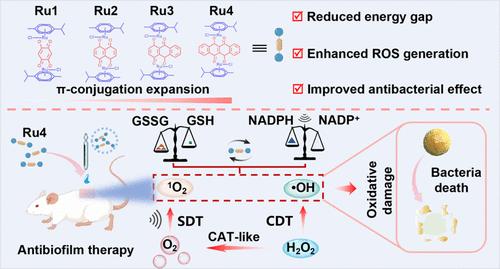Strategically Engineered Ru(II) Complexes with Enhanced ROS Activity Enabling Potent Sonodynamic Effect against Multidrug-Resistant Biofilms
IF 8.3
2区 材料科学
Q1 MATERIALS SCIENCE, MULTIDISCIPLINARY
引用次数: 0
Abstract
Sonodynamic therapy (SDT) can generate reactive oxygen species (ROS) to combat multidrug-resistant biofilms, which pose significant challenges to human health. As the key to producing ROS in SDT, the design of sonosensitizers with optimal molecular structures for sufficient ROS generation and activity in complex biofilm matrix is essential. In this study, we propose a π-expansion strategy and synthesize a series of small-molecule metal Ru(II) complexes (Ru1–Ru4) as sonosensitizers (Ru1–Ru4) to enhance the efficacy of SDT. Among these complexes, Ru4 demonstrates remarkable ROS generation capability (∼65.5-fold) that surpasses most commercial sonosensitizers (1.3- to 6.7-fold). Through catalyzing endogenous H2O2 decomposition, Ru4 facilitates the production of abundant O2 as a resource for 1O2 and the generation of new ROS (i.e., •OH) for improving SDT. Furthermore, Ru4 maintains the sustained ROS activity via consuming the interferences (e.g., glutathione) that react with ROS. Due to these unique advantages, Ru4 exhibits potent biofilm eradication ability against methicillin-resistant Staphylococcus aureus (MRSA) both in vitro and in vivo, underscoring its potential use in clinical settings. This work introduces a new approach for designing effective sonosensitizers to eliminate biofilm infections, addressing a critical need in healthcare management.

战略设计的 Ru(II) 复合物具有更强的 ROS 活性,可对耐多药生物膜产生强大的声动力效应
声动力疗法(SDT)可产生活性氧(ROS),以对抗对人类健康构成重大挑战的多重耐药生物膜。作为在声动力疗法中产生 ROS 的关键,设计具有最佳分子结构的声敏化剂至关重要,这样才能在复杂的生物膜基质中产生足够的 ROS 并发挥其活性。在本研究中,我们提出了一种π-扩展策略,并合成了一系列小分子金属 Ru(II) 复合物(Ru1-Ru4)作为声纳敏化剂(Ru1-Ru4),以增强 SDT 的功效。在这些配合物中,Ru4 具有显著的 ROS 生成能力(65.5 倍),超过了大多数商业声波敏化剂(1.3 至 6.7 倍)。通过催化内源性 H2O2 分解,Ru4 可产生丰富的 O2 作为 1O2 的资源,并产生新的 ROS(即 -OH)以改善 SDT。此外,Ru4 还能通过消耗与 ROS 发生反应的干扰物(如谷胱甘肽)来维持 ROS 的持续活性。由于这些独特的优势,Ru4 在体外和体内对耐甲氧西林金黄色葡萄球菌(MRSA)都表现出了强大的生物膜根除能力,突出了其在临床环境中的潜在用途。这项研究为设计消除生物膜感染的有效声波敏化剂引入了一种新方法,解决了医疗保健管理中的一个关键需求。
本文章由计算机程序翻译,如有差异,请以英文原文为准。
求助全文
约1分钟内获得全文
求助全文
来源期刊

ACS Applied Materials & Interfaces
工程技术-材料科学:综合
CiteScore
16.00
自引率
6.30%
发文量
4978
审稿时长
1.8 months
期刊介绍:
ACS Applied Materials & Interfaces is a leading interdisciplinary journal that brings together chemists, engineers, physicists, and biologists to explore the development and utilization of newly-discovered materials and interfacial processes for specific applications. Our journal has experienced remarkable growth since its establishment in 2009, both in terms of the number of articles published and the impact of the research showcased. We are proud to foster a truly global community, with the majority of published articles originating from outside the United States, reflecting the rapid growth of applied research worldwide.
 求助内容:
求助内容: 应助结果提醒方式:
应助结果提醒方式:


